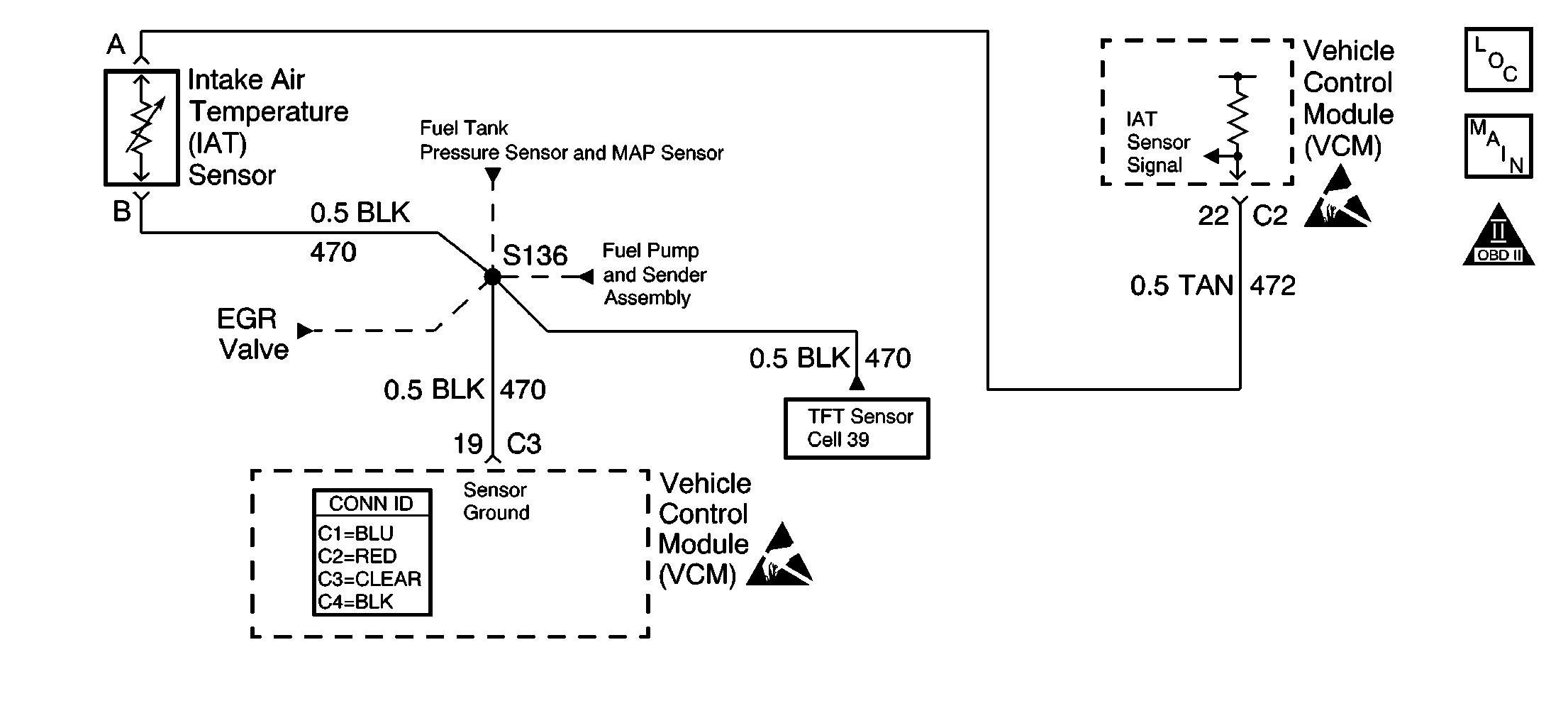
Circuit Description
The intake air temperature (IAT) sensor is a thermistor. The control module supplies the IAT sensor a reference voltage on the IAT sensor signal circuit and a ground circuit. When the IAT sensor resistance is high, indicating a cold sensor, the IAT sensor signal voltage remains near the supplied voltage and decreases the signal voltage as the sensor warms. The control module monitors the IAT sensor signal circuit in order to calculate the temperature of the air entering the engine.
This DTC is designed to detect an IAT sensor signal voltage lower than possible in a normally operating IAT sensor.
Conditions for Running the DTC
| • | There are no active vehicle speed sensor (VSS) DTCs. |
| • | The vehicle speed is more than 2 MPH. |
| • | The engine has been running for more than 100 seconds. |
Conditions for Setting the DTC
The IAT voltage is less than a calibrated value for more than 5 seconds.
Action Taken When the DTC Sets
| • | The control module illuminates the malfunction indicator lamp (MIL) if a failure is detected during 2 consecutive key cycles. |
| • | The control module sets the DTC and records the operating conditions at the time the diagnostic failed. The failure information is stored in the scan tool Freeze Frame/Failure Records. |
Conditions for Clearing the MIL or DTC
| • | The control module turns OFF the MIL after 3 consecutive drive trips when the test has run and passed. |
| • | A history DTC will clear if no fault conditions have been detected for 40 warm-up cycles. A warm-up cycle occurs when the coolant temperature has risen 22°C (40°F) from the startup coolant temperature and the engine coolant reaches a temperature that is more than 70°C (158°F) during the same ignition cycle. |
| • | Use a scan tool in order to clear the DTCs. |
Diagnostic Aids
The IAT sensor indicates the temperature of the ambient air entering the throttle body. The IAT sensor temperature reading should be very close to the temperature of the outside air. The IAT sensor temperature should rise gradually as the engine warms up and the underhood temperature increases. If DTC P1112 is set, the problem is intermittent. Check for a short to ground in the IAT sensor signal circuit. This may be accomplished by moving the VCM harness at various locations and monitoring the IAT temperature or the IAT voltage on the scan tool. If the voltage varies, look for a short to ground in the area of the harness that caused the variance. Also, a sensor may become skewed or mis-scaled. The Temperature vs. Resistance Value Table will help to detect a skewed sensor. Refer to Temperature Versus Resistance .
Action Taken When the DTC Sets
If equipped, the following actions occur:
| • | The EBCM disables the ABS/TCS/VSES for the duration of the ignition cycle. |
| • | The ABS indicator turns ON. |
| • | The TRACTION CONTROL indicator turns ON. |
| • | The DIC displays the SERVICE STABILITY SYS message. |
| • | For some DTC C1255xx, the EBCM disables the variable effort steering (VES) for the duration of the ignition cycle and the DIC displays the SERVICE STEERING SYS message. |
Test Description
The numbers below refer to the step numbers on the diagnostic table.
Important: Use the same diagnostic test equipment for all the measurements.
-
If the IAT sensor circuit voltage measures less than 0.82 volts, the conditions for the DTC are still present and the problem is not intermittent.
-
Disconnecting the IAT sensor harness connector will provide a high voltage input to the VCM. The VCM should recognize this high voltage and indicate a low IAT temperature on the scan tool. Disconnecting the IAT sensor harness could also set additional IAT related codes.
Step | Action | Value(s) | Yes | No |
|---|---|---|---|---|
1 | Did you perform the Powertrain On-Board Diagnostic (OBD) System Check? | -- | ||
Is the voltage less than the specified value? | 0.82 V | |||
Is the voltage more than the specified value? | 4.0 V | |||
4 |
Did you find a problem? | -- | ||
5 | The DTC is intermittent. Are any additional DTCs stored? | -- | Go to the applicable DTC tables | Go to Diagnostic Aids |
6 | Repair the short to ground in the IAT sensor signal circuit. Refer to Wiring Repairs in Wiring Systems. Is the action complete? | -- | -- | |
7 | Replace the IAT sensor. Refer to Intake Air Temperature Sensor Replacement . Is the action complete? | -- | -- | |
8 |
Important: The replacement VCM must be programmed. Replace the VCM. Refer to VCM Replacement/Programming . Is the action complete? | -- | -- | |
9 |
Does the scan tool indicate the diagnostic Passed? | -- | ||
10 | Does the scan tool display any additional undiagnosed DTCs? | -- | Go to the applicable DTC table | System OK |
